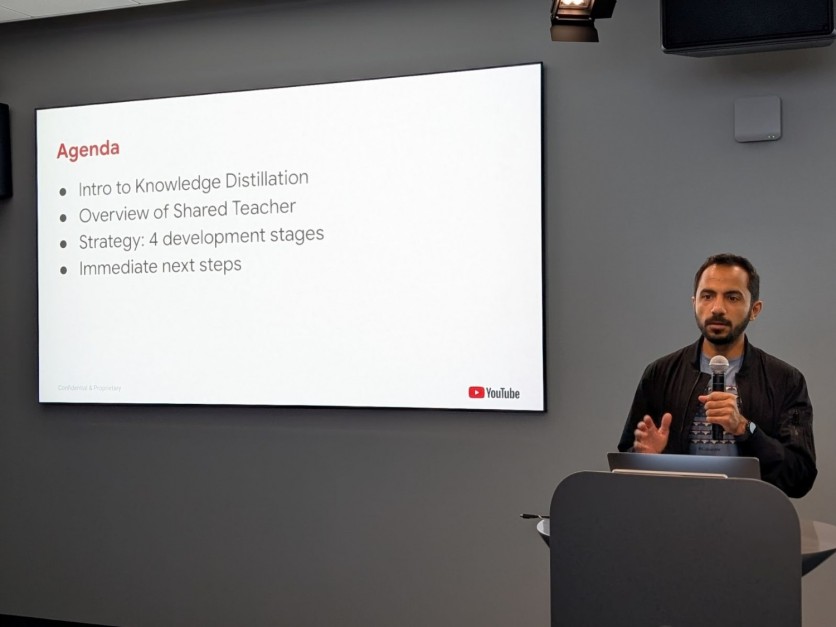
Google has been a significant contributor to technological innovation, influencing various industries through its projects. The PageRank algorithm altered how information is organized and accessed online, while the Android operating system expanded access to smartphones. Google Cloud Platform has provided businesses with increased scalability and flexibility in cloud computing, and TensorFlow has contributed to advancements in Artificial Intelligence (AI) and machine learning across different sectors. With YouTube as well, Google has made a big impact in the entertainment industry by making personalized content easily accessible to everyone.
Recently, Google has made strides in content delivery and recommendation systems at YouTube, particularly through the application of Knowledge Distillation (KD). Nikhil Khani, a Senior Software Engineer at YouTube, has been instrumental in these developments. His work on KD has improved YouTube's recommendation system by optimizing machine learning models for efficiency and scalability. This technique transfers knowledge from a large model to a smaller one, aiming to obtain superior performance while reducing computational requirements. Under Khani's guidance, KD has been applied to enhance user engagement and content discovery. His work demonstrates the potential of AI techniques to influence user experiences and technological development across industries.
Disrupting Content Delivery with Knowledge Distillation
At YouTube, the homepage is the first touchpoint for users, and the quality of recommendations here defines their overall experience. Khani's work on KD has been critical in enhancing these recommendations. In April 2022, Khani was a vital contributor to the launch of KD on YouTube's homepage. KD presents challenges, particularly around training a large, potentially unstable teacher model. Khani led the effort to overcome these hurdles, designing a robust loss function and training pipeline. His architectural choices were critical in stabilizing the teacher model and facilitating the annotation of the student dataset with teacher labels. This initiative aimed at improving recommendation quality without compromising latency, increased Daily Active Users (DAU), and increased YouTube Time on the platform, adding millions of hours of daily watch time and new users to YouTube.
Khani's efforts did not stop there. He led another project aimed at further scaling up the teacher and training a student distilled from it. This project pioneered the demonstration at the internet scale that enhancing the teacher model's performance can significantly improve the student model's effectiveness. The result was an additional gain in YTT, equating to millions of hours of watch time daily. Recognized as one of the most impactful launches at YouTube for the year, Khani's work earned him a Spot Award from the VP of YouTube Recommendations.
Operational Efficiency and Cost Savings
Another significant achievement in Khani's career was optimizing YouTube's ML infrastructure. After reducing the Tensor Processing Unit (TPU) costs associated with the ranking models through Knowledge Distillation, Khani further optimized the operational cost by pruning unnecessary or redundant parts of the model and migrating it to a parameter-efficient architecture like Residual Networks (ResNets) in total saving YouTube approximately $1.3 million in TPU costs. To achieve these cost savings without compromising the recommendation system's performance, Khani's expertise in the area is demonstrated.
Khani's launch of a significantly larger teacher model, the largest at YouTube at the time, showcased the scalability of KD techniques. This model was shared across multiple teams at Google, enabling them to use the distilled knowledge for their specific applications.
The shared teacher model improved the efficiency of machine learning models across Google and fostered a culture of collaboration and resource optimization. The successful implementation of KD techniques across different teams highlights the broader applicability and benefits of this approach. Notably, the paper detailing this work was accepted as an Industry Paper for the RecSys 2024 and published in the prestigious Association for Computing Machinery (ACM) journal.
TPU Optimizations: A Critical Component
In addition to his work on KD, Khani has made significant contributions to optimizing the use of Tensor Processing Units (TPUs) at Google. During the global chip shortage, securing TPUs became challenging, and Khani's initiatives to minimize TPU wastage were crucial. He led a project with the goal of reducing TPU wastage across YouTube by identifying and cleaning up idle resources.
Khani's team designed a tagging procedure that instrumented the entire TPU fleet, adding detailed instrumentation with information about the rest of the Google stack. This allowed them to identify stale TPUs that were not being utilized actively.
The project saved approximately $5 million annually in cost savings. This innovative solution also earned Khani the Code Excellence Award for its novelty and ingenuity in improving YouTube's bottom line.
Broader Industry Impact
Khani's work on Knowledge Distillation (KD) has had an impact on various projects within Google and beyond. Initially implemented for YouTube's Homepage, Khani's work is now extended to WatchNext (to determine subsequent videos to play) and is also being adapted by YouTube Shorts. This expansion across different surfaces within YouTube demonstrates the versatility and effectiveness of KD in optimizing machine-learning models for better performance and user engagement.
There's another side to these technological innovations. Big Tech today consumes more electricity than some countries, and in cases like these, Khani's work shows how business goals can be achieved sustainably. KD has decreased carbon emissions equivalent to driving 93,000 miles in an average gasoline car or the carbon sequestered by planting 6,100 trees by reducing the computational demand of machine learning models. This reduction highlights the impact of KD to improve technological efficiency and contribute positively to environmental sustainability. As industries increasingly prioritize eco-friendly practices, Khani's contributions offer a model for balancing technological advancement with environmental responsibility.
His techniques and leadership in implementing KD have benefited YouTube and influenced other firms beyond Google, driving AI-powered efficiency and fostering a culture of collaboration. Reflecting on his journey, Khani remarks, "Innovation is about solving real-world problems and making a meaningful impact. That's what motivates me every day."
ⓒ 2025 TECHTIMES.com All rights reserved. Do not reproduce without permission.




